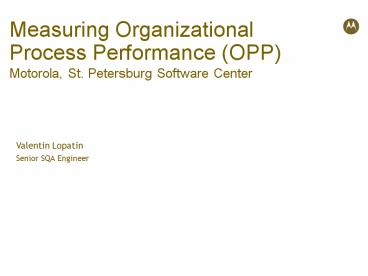Measuring Organizational Process Performance OPP PowerPoint PPT Presentation
1 / 18
Title: Measuring Organizational Process Performance OPP
1
Measuring Organizational Process Performance (OPP)
- Motorola, St. Petersburg Software Center
Valentin Lopatin Senior SQA Engineer
2
Why Measure Process?1
- Quality is vital for Business success
- The quality of a system is governed by the
quality of the process used to develop it - You cant control what you cant measure
Tom DeMarco
3
Why Measure Process?2
- Monitoring the processes used to develop the
products - taking corrective actions based on objective data
(metrics) - Understanding the capability of the processes
with regard to customer or management
requirements - Voice of Process vs. Voice of Customer
- Predicting the parameters of the processes
- Taking preventive actions
4
CMMI says
The purpose of Organizational Process Performance
(OPP) is to establish and maintain a quantitative
understanding of the performance of the
organizations set of standard processes in
support of quality and process-performance
objectives, and to provide the process-performance
data, baselines, and models to quantitatively
manage the organizations projects.
5
Measurement Cycle1
Organization Metrics Set
Organization Goals
GQM
Project 1
Project 2
Organization Database
Project
Project N
GQM - Goal-Question-Measurement paradigm
6
GQM paradigm
7
Measurement Cycle2
Organization Metrics Set
Key Indicators
Key Processes
Organization Goals
GQM
Baselines (LCL-CL-UCL)
Project 1
Project 2
Organization Database
Project
Project N
8
Measurement Cycle3
Organization Metrics Set
Key Indicators
Key Processes
Organization Goals
GQM
Baselines (LCL-CL-UCL)
Project Characterization - type
- size - lifecycle
-
Process Performance Models
Project 1
Project 2
Organization Database
Project
Project N
9
Project Metrics Report
- All project related information is in one
place - Project Manager dashboard
Automatic Baselines tracking
Tracking of quality goals achievement
10
Process Performance ModelCost of Quality
Prediction
- Forecasting of the parameter which final value
can be measured at the end of the project - Typically done during planning phase
- Follows a component-based approach
- Is automated through a COQ Prediction Tool
- Is tracked through a Project Metrics Report
11
Metrics System Structure1
12
Metrics System Structure2
- Peer Reviews Tool
- Defect Prevention Activities Registration Tool
- Project Registration Tool
- Web Approval Tool
13
Metrics System Structure3
- Defect Tracking System Integration
- Revision Management System Integration
- MS Excel Integration
14
Metrics System Structure4
- MS Excel Web Query Feature
- DB views usage
15
Quality Goals Status Report
- Quality Goals Status Report helps to
- Track quality goals on operation/organization
levels - Predict year end values of key indicators
- Take corrective actions at early stages
- Identify lessons learned
16
OPP Framework
analyzing
Organizational Scorecard
strategic planning
analyzing
Process Performance Models
Quality Goals Status Report
Organizational Quality Plan
Metrics Program
PCB
planning
Project Quality Plan
Metrics Database
Customer Specific Goals
planning
planning
- Goals
- Action Plans
- Metrics
- PCB
- Audits
recording
tracking controlling
Project Metrics Report PCB Outbreak Analysis,
Operations Review, Project Raw Data, Metrics
Review
17
Conclusions
- Strong linkage of Metrics Program to Business
Goals - use of GQM paradigm
- Sophisticated design of metrics database
- Data inconsistency reduction
- All composite metrics based on raw data
- Flexibility to be in line with business needs
- Single Data source
- Focused on automation
- Use of Statistical Process Control methods
- To understand process capabilities
- To predict process performance
- Focus on controlling performance of key processes
- CMMI as a framework for taking advantage of
measuring process performance
18
- Thank you!
- QUESTIONS?

